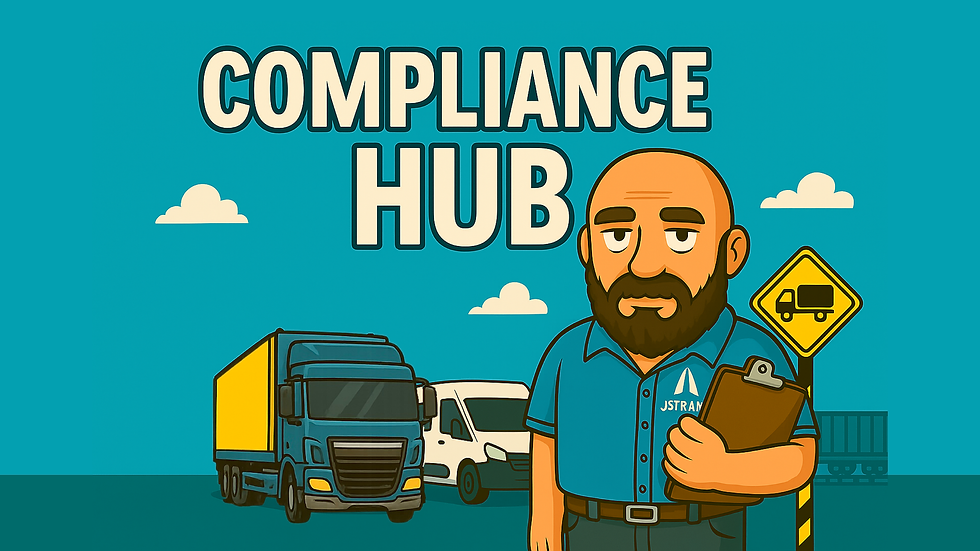Driver Licence Checks for Small Fleet Operators
- stuart47304
- Jul 14, 2025
- 4 min read

As a small fleet operator — especially under a Restricted Operator Licence — you might assume that driver licence checks are a “big business” problem.
But think again.
Even if you're the only driver, or just using one or two others occasionally, you are legally responsible for ensuring that every driver is licensed, qualified, and legal to drive your vehicles. Failing to check properly can lead to:
Insurance being invalidated
DVSA sanctions
Traffic Commissioner action
Prohibitions or even loss of your licence
This guide shows you how to set up a simple, effective and compliant licence-checking system that suits your scale — whether you're a one-man band or running a handful of vehicles.
🚨 Why Licence Checks Matter
Every year, thousands of drivers:
Have their licences suspended or revoked
Get banned for totting-up offences
Get provisional or expired entitlements
Fail to notify employers about points or disqualifications
As the operator, it’s your job to make sure drivers are eligible and legal. If a driver is unlicensed or disqualified, and you let them drive — you are at fault, not just them.
The DVSA and Traffic Commissioner will ask:
“What system did you have in place to check their licence status?”
✅ What You Must Check
Whether the driver is full-time, part-time, agency, or even you, you must check:
Checkpoint | What to Confirm |
Licence validity | In-date and not expired |
Correct entitlements | E.g. Category C1, C, C+E for HGVs |
Points and offences | Are they within insurance policy and employer tolerance? |
Medical status | Especially for drivers over 45 or with conditions |
CPC status (if required) | Valid Driver Qualification Card (DQC) for HGV drivers |
Tachograph card (if required) | In-date and assigned |
📋 How Often Should You Check?
Driver Type | Frequency Recommended |
Yourself (owner-driver) | Every 6 months |
Employed drivers | Every 3–6 months |
Agency/casual | Every engagement |
New hires | Before they start driving |
⚠️ If a driver gains 6+ points, checks should be more frequent — e.g. every 1–2 months.
🛠️ How to Check a Licence – Step-by-Step
Option 1: Use the DVLA Online Service
You’ll need:
The driver’s permission
Their Driving Licence Number
Their National Insurance Number
Their Postcode
This will show:
Valid licence status
Categories/entitlements
Expiry date
Penalty points and offences
Disqualifications (if any)
✅ Print or save a PDF of the results for your records.
Option 2: Use a Third-Party Licence Check Provider
These services link to the DVLA and offer batch checks, alerts, and automated reporting.
Examples include:
Licence Check
TrustID
DriverCheck
FleetCheck
DAVIS
This is ideal for fleets with multiple drivers and saves admin time. Costs range from £1–£3 per check.
📂 What Records Should You Keep?
You should maintain a Driver Licence File for each driver, containing:
Document | Details |
Photocopy of licence | Both sides of photocard |
DVLA check result | Printed or PDF result |
Signed permission form | Allowing you to make checks |
CPC card copy (if required) | Front and back |
Tachograph card copy | Optional, but useful |
Check log | Dates, results, initials |
Keep these records for at least 15 months, longer if part of your driver history or audit trail.
🧾 Sample Check Log (Manual)
Driver | Date | Checked By | Result | Action |
J. Smith | 15/07/2025 | Admin | Valid, 3 pts | No action |
A. Brown | 12/06/2025 | Self | Valid, CPC due 08/25 | Reminder set |
✅ Best practice: Maintain this log digitally or scan to cloud storage.
📑 Template: Driver Declaration Form
Create a short form for drivers to sign every 6 months. It should include:
Full name
Declaration that the licence is valid
Confirmation of no new convictions
Declaration that they will report future offences
Signature and date
This supports your system and shows the Traffic Commissioner that you’re being diligent.
👨👩👦👦 Casual, Agency & Temporary Drivers
If you use drivers who aren't directly employed:
Check their licence every time they drive for you
Don’t rely solely on the agency — do your own check
Retain a log or screenshot showing they were valid on that day
📦 What If You Discover a Problem?
If a check shows:
Problem | Action to Take |
Expired entitlement | Remove driver from duty immediately |
Too many points (e.g. over 6–9) | Review against your insurance policy and risk policy |
No CPC or tachograph card | Cannot drive HGVs legally — remove from duty |
Disqualification | Inform your insurer and stop all driving activities |
Driver refuses to give consent | You cannot let them drive |
Record the issue, what action you took, and keep documentation.
🧠 Final Thoughts
Licence checks might seem like a small task — but getting them wrong can cost you your licence, your insurance, or even your business.
As a Restricted Licence holder, you must take personal responsibility. There’s no TM watching over you — so:
✅ Set up a routine check cycle
✅ Keep accurate records
✅ Stay on top of renewals and points
✅ Use digital tools if possible
✅ Apply the same rules to casual drivers as you would full-time staff
With a simple, consistent system, you’ll stay safe, legal, and ahead of the DVSA.
Next in the series:👉 Tachographs for Business Owners: Do You Really Need One?
